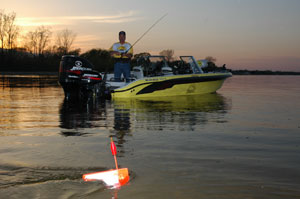 Close your eyes for a minute. Now walk around the house trying to find things that you use every day. The sink, the television set, even big items like the dining room table or stuff that makes noise like the refrigerator are hard to find in the dark. We take our sight for granted, never giving much thought to what it would be like to live in a world of darkness.
Close your eyes for a minute. Now walk around the house trying to find things that you use every day. The sink, the television set, even big items like the dining room table or stuff that makes noise like the refrigerator are hard to find in the dark. We take our sight for granted, never giving much thought to what it would be like to live in a world of darkness.
Walleye are also largely dependent upon their sight to find food. This particular species has a refined sense of smell, excellent hearing and they can actually detect things moving in the water by means of a sensory organ known as the lateral line. Despite these highly refined senses, the sense of sight is the primary tool walleye use to locate and catch their food.
When darkness comes it stands to reason that a sight feeding species like the walleye would suffer. Not really. This particular species isn’t as seriously handicapped in low light as you might imagine. The large size of the walleye’s eye does an excellent job of collecting available light. Like an oversized objective lens on a rifle scope, the big eye of the 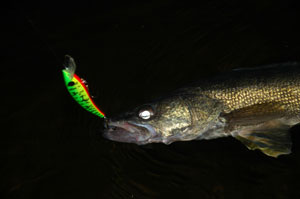 walleye plays an important role in capturing light. Coupled with the fact these fish also have bonus rods and cones in their eyes compared to other fish is another indication that walleye have a sight advantage even in the dark of night.
walleye plays an important role in capturing light. Coupled with the fact these fish also have bonus rods and cones in their eyes compared to other fish is another indication that walleye have a sight advantage even in the dark of night.
Walleye are blessed with the gift of low light vision, but it’s important to note that this gift isn’t the equivalent of x-ray vision. In low light or dirty water situations walleye don’t see as well as they otherwise would in brighter conditions or clearer water. This explains way walleye are often so difficult to catch in dirty water.
We know that walleye are sight feeders and we also know that they have a sight advantage in low light. Combine these skills with the preferred hunting strategy of the walleye and it becomes very clear why fishing after dark is such a productive time to target walleye.
Walleye are not ambush feeders like a bass that hides against a rock or stump and darts out to grab prey as it passes by. Instead, a school of walleye cruise around like a wolf pack seeking out the weak or sick. Something that stands out as being different immediately catches the attention of these fish.
Not having the element of surprise to aid them, walleye work over a school of baitfish by literally herding the minnows into places where they can more easily catch them. Places where there is deep water near shore are prime spots for walleye to hunt because they can trap minnows against a steep shoreline. Seawalls, piers and rip rap banks are some manmade structures that create the same hunting advantage for the walleye.
In the absence of these physical features, walleye will often herd minnows to the surface, trapping them just as effectively in the surface film. Under the cover of darkness much of this feeding activity takes place in shallow water or near the surface. Because walleye are constantly on the prowl and always looking for prey that’s easy to catch, they become vulnerable to anglers who understand just how to appeal to these low light predators.
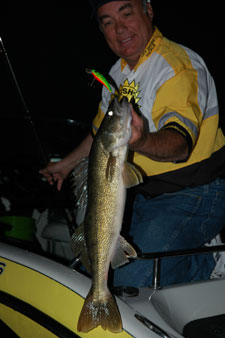 SIZE MATTERS
SIZE MATTERS
During the light of day walleye enjoy a defined sight advantage. Even small objects quickly catch their attention. Think back to all the walleye you’ve caught on a 1/16 or 1/8 ounce jig.
At night using small lures is a handicap simply because walleye can’t see them as well as they can see larger lures. Small lures like jigs are therefore better replaced with things like crankbaits. Among the many crankbaits available, the best producing models tend to be (you guessed it) bigger sized baits.
In the dark, bigger is almost always better when it comes to crankbaits. This poses a bit of a problem, because in the world of crankbaits, larger lures tend to also be the deeper diving models.
The answer to this problem is a family of shallow diving crankbaits known as stickbaits. Long and slender in shape, stickbaits feature a small diving lip that delivers only modest diving ability. Most stickbaits dive from six to eight feet deep, making them an excellent choice for both casting and trolling situations.
Stickbaits are also available in sizes ranging from modest to monstrous. Lures in the four to eight inch range are among the best choices for walleye fishing after dark.
CAST OR TROLL?
Both casting and trolling are effective ways to target night time walleye. Which presentation is best depends completely on the fishing situation.
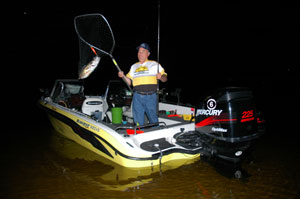 Meandering weed edges are a situation that screams out for crankbait casting. Walleye often cruise along meandering weed edges, hunting for baitfish foolish enough to stray from the protection of the weeds. Positioning the boat in deep water and casting shallow diving crankbaits up into the weeds or parallel to the weed edge can be an exciting way to target night time walleye.
Meandering weed edges are a situation that screams out for crankbait casting. Walleye often cruise along meandering weed edges, hunting for baitfish foolish enough to stray from the protection of the weeds. Positioning the boat in deep water and casting shallow diving crankbaits up into the weeds or parallel to the weed edge can be an exciting way to target night time walleye.
Because the weed edge meanders, it’s neither easy nor practical to troll and follow the edge. Casting makes the most sense in this particular situation.
Casting can also be effective when fishing from shore along piers, seawalls or rip rap. Often the best fishing is concentrated around dock lights that attract baitfish. These isolated spots are not practical to troll, but can be easily targeted by casting crankbaits.
Trolling shines best when the fish are found scattered along a defined edge. Channels that have rock bank protection on one or both sides are a perfect example of a situation where flatline or structure trolling shines best. Because the fish are not typically concentrated in one particular area, trolling covers water quickly and becomes the most practical way to contact fish.
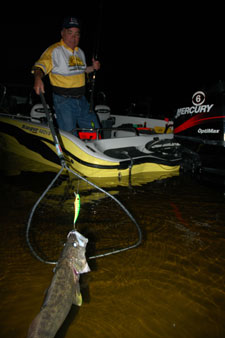 In the Great Lakes drowned river mouth lakes are common. The channels that connect the inland lake to the Great Lakes provide some amazing walleye action after dark. Generally, these fish live in the inland lake during the day and make nighttime migrations to the channels after dark to hunt for shad or alewives that move back and forth between the inland lake and the Great Lakes.
In the Great Lakes drowned river mouth lakes are common. The channels that connect the inland lake to the Great Lakes provide some amazing walleye action after dark. Generally, these fish live in the inland lake during the day and make nighttime migrations to the channels after dark to hunt for shad or alewives that move back and forth between the inland lake and the Great Lakes.
Trolling in open water with the help of planer boards may well be the most efficient way of targeting night feeding walleye. Any body of water that has a suspended forage base is a prime target for trolling walleye after dark. Walleye push these baitfish to the surface, where they simply slurp in the bewildered baitfish at will.
Because the action is close to the surface, shallow diving stickbaits are the crankbait of choice. In order to fish more lines and cover additional water, in-line planer boards like the famous Off Shore Tackle Side-Planer become critical to fishing success.
In-line boards function both as a means of spreading out lines and also as strike indicators. When a fish is hooked, the planer board is pulled backwards in the water. Of course, in the dark special lights must be added to the boards so these strikes can be detected.
The Off Shore Tackle Night Light kit contains two lights mounted on flag stems that are easily screwed to the Off Shore board. These battery operated lights are waterproof, feature a light emitting diode that never needs replacing and they come in both green and red colors for port and starboard side fishing.
A spread of four lines each equipped with shallow diving stickbaits and four in-line planer boards represents a good night trolling set up. In the dark it’s good advice to keep things as simple as possible. This goes double when trolling. A clean and well organized boat is the best platform for night trolling.
SLOW IT DOWN
Bigger lures are easier for walleye to spot in the dark. In the same token, using slower than normal retrieve and trolling speeds makes sense. A slow and steady retrieve speed will produce the most bites when casting. For trolling, keep the speed below two miles per hour and in cold water conditions slow it down even more.
SUMMING IT UP
When darkness falls the fishing day doesn’t have to end. Walleye are well adapted to feeding after dark and with a few tips anglers can be just as well adapted at catching this popular species.










